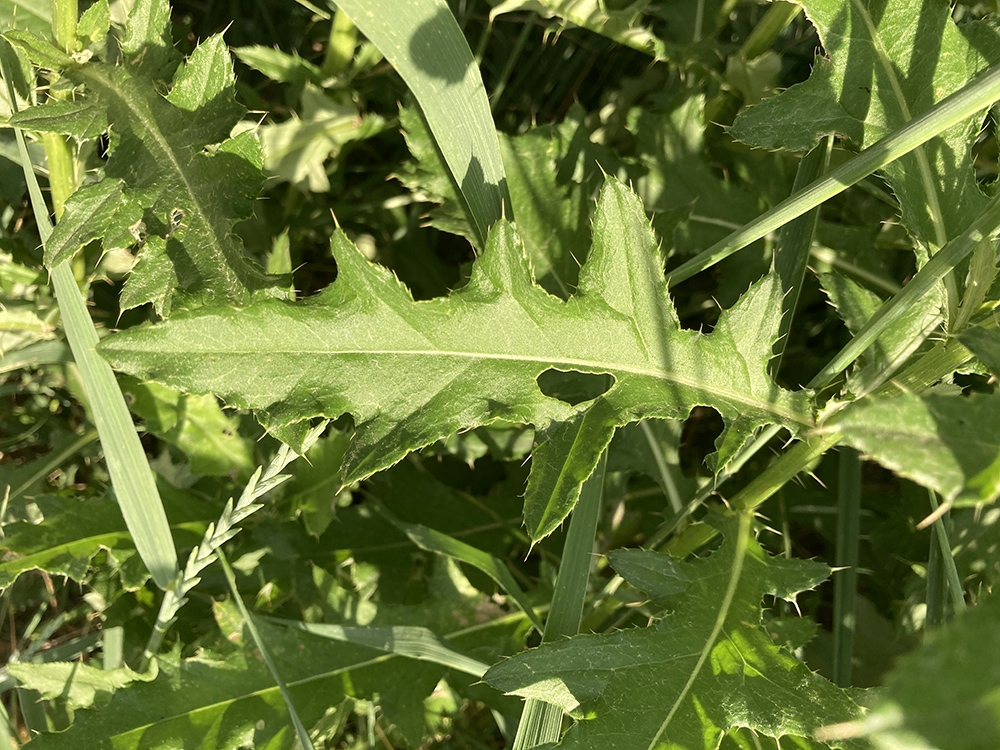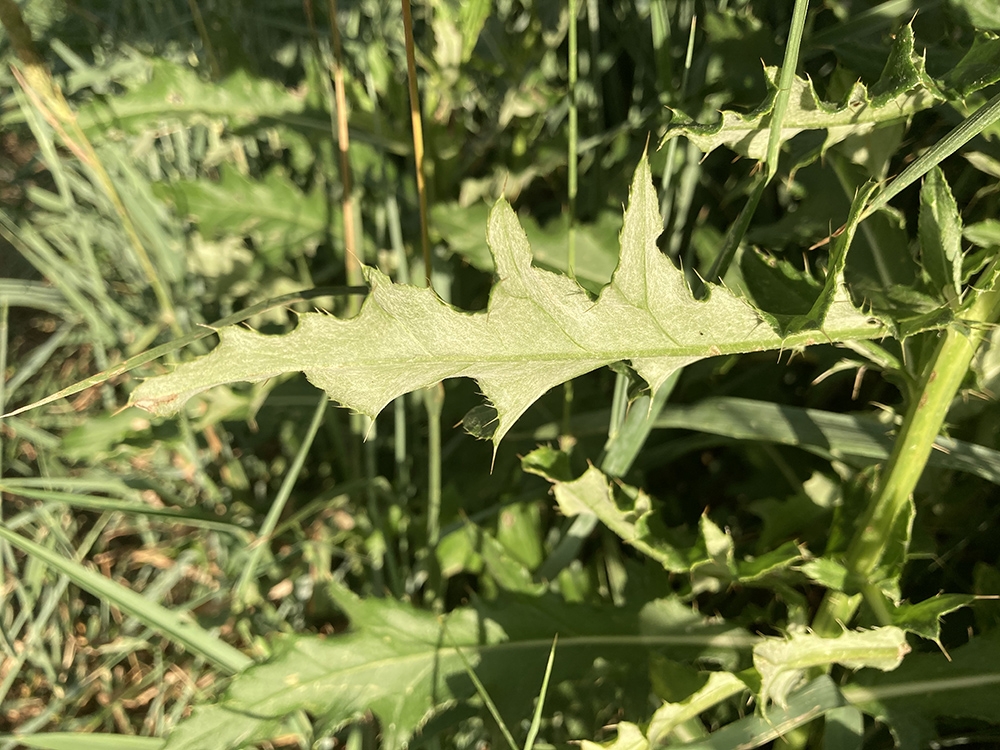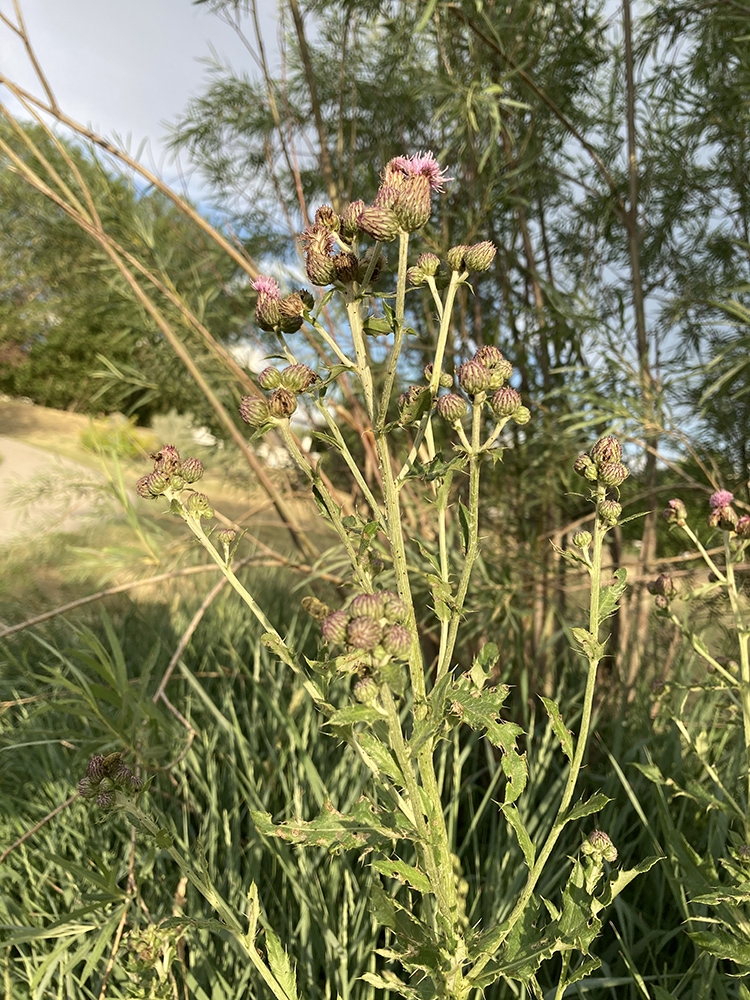Weed Profile: Canada thistle (Cirsium arvense)
Summer is officially underway. The cast of spring-blooming flowers we so eagerly awaited has been replaced by a rowdy and colorful mid-season crowd, who are having their day in the sun. And, while the initial excitement of the gardening season has not faded for many of us, reality has set in: weeds have proliferated alongside our beloved landscaping plants. Perhaps we were out of town for a couple of days, shifted our focus to a project other than our yards or needed a respite from the soaring 90°F temperatures. Meanwhile, weeds jumped at the opportunity, marched up and down sidewalk cracks and fence lines, colonized the darkest and most clay-heavy corners of our yards, and scrambled brazenly up desirable plants with their tendrils.
Some of these weeds are annuals or biennials that are easily addressed in an après-dinner weed-pulling session, accompanied with a beverage and snippets of conversations with friendly passersby. Pleasant enough. However, there’s that suite of more problematic weeds, perennials that reproduce vegetatively, creating clones of themselves until their radius expands. These are the weeds we pull repeatedly, only to become overwhelmed when they return with an exponential vengeance. One such weed is Canada thistle (Cirsium arvense).
Identifying Canada Thistle
A colony-forming species, Canada thistle emerges in the spring, punctuating yards (and other disturbed sites) with rosettes of leaves. Leaves are spiny lobed and from 4 to 8 inches long, mostly smooth and green above and white-woolly below. Around the time spring transitions to summer, a flower head emerges with one to five small pink to purple (rarely white) flowers. Fun fact: This species is dioecious, meaning individual plants have either female or male flowers. At maturity, Canada thistle stands 3 to 5 feet tall. What you don’t see is most of the plant—an extensive creeping root system that penetrates the soil to depths of 6 to 15 feet.
Since its arrival to North America several hundred years ago, Canada thistle has spread throughout much of Canada and the United States and is considered a noxious weed (list B) in Colorado. It aggressively competes with native plants, reduces crop productivity by vying for essential resources such as space, nutrients, light and water, is unpalatable to livestock and, if left to its own devices, can form monocultures in our yards. These are all compelling reasons to manage this species, but where to begin?
Research suggests that a combination of approaches works best for managing Canada thistle. Below are several suggestions:
Mow frequently or cut back the rosettes with clippers from when the plant emerges in the spring through summertime. This will prevent flower formation and will also stress the plant by reducing carbohydrate storage in roots.
Glyphosate: From late summer up until the first hard freeze, spot treat by applying glyphosate to Canada thistle leaves using a paintbrush. The herbicide will be translocated to the underground parts of the plant, ultimately bringing about its demise.
Plant regionally appropriate plants: Once your yard’s thistle population is under control, plant regionally appropriate plants including a diversity of natives and Plant Select® plants. These require fewer inputs, including less fertilizer and water. Where bare ground remains, apply mulch. Covering bare ground with plants and mulch will make your yard less prone to future weed infestations.
Puccinia punctiformis, a rust fungus that is host-specific and pathogenic to Cirsium arvense, shows great promise in managing Canada thistle populations. This biocontrol is currently being evaluated in Colorado for appropriate application timing and best methods. To learn more or to order, visit the Colorado Department of Agriculture’s Request-A-Bug page.
Although Canada thistle is one of the more challenging weeds to manage, the good news is that with a multi-pronged approach over the course of several seasons, it is entirely possible to eradicate this weed from our yards.
Gallery




Comments
DBG suggestion of using Glyphosate
Thank you for this article on the canadian thistle. I appreciate the information - though it might be more responsible for the DBG to NOT suggest people apply Glyphosate to their yards in order to control the weed. Given that there are ongoing disagreements by scientists regarding its safety for humans and our ecosystem. Maybe propose something less toxic - even just a bit of elbow grease to dig it out, and/or some table vinegar.
Hi Gianna, Thank you for…
Hi Gianna,
Thank you for your comment! I wanted to address this point in more depth in my blog post, but I was working with a word limit constraint, so I am happy you brought this up.
As you pointed out this is a hotly debated topic and an agreement regarding the safety of glyphosate to humans and the environment has not been reached. In the meantime, glyphosate has certainly been both overused and irresponsibly used. However, there are a few instances when I feel its use is warranted, and one of these is for Canada thistle.
Unfortunately, because Canada thistle roots can reach depths of 6-15 ft (https://wric.ucdavis.edu/information/natural%20areas/wr_C/Cirsium_arvense.pdf), and also because it reproduces vegetatively, eradication of this weed can be very difficult. Gardeners can spend much time pulling the plants, but since much of their biomass is underground, Canada thistle often grows back. As for vinegar, it will kill the leaves of the plant as it damages the cuticle, but it is not translocated into the root system. As far I know, no organic herbicide is. Sure, elbow grease and the use of vinegar stress the plants out, so they are good tools to include in an integrated pest management (IPM) approach for Canada thistle. Which brings up a good point: if herbicide is used, it should only be used in combination with other IPM methods.
One thing I suggest is that if gardeners do choose to use glyphosate, they should apply it in a very targeted manner. Thus, instead of spraying plants I advocate for using a paintbrush to apply glyphosate to the leaves of Canada thistle. Of course, gardeners should follow the directions on the label too.
Finally, glyphosate should not be a long-term solution. It should only be used as the means to an end, which is to create a healthy, productive, biodiverse landscape. A personal example is that several years ago I inherited a Canada thistle infestation in my yard. I quickly became obsessed with getting rid of it. For two years, at the beginning of the growing season I would take scissors and cut back each individual Canada thistle plant to the ground. Towards the end of the summer I applied glyphosate each time a rosette emerged. I then mulched any areas that I was not immediately going to landscape. Other areas I landscaped with a wide diversity of Plant Select plants, Colorado natives, and other plants that thrive in our arid environment.
The Canada thistle has been eradicated. Because I stay on top of weeding and I am constantly monitoring for new infestations, I doubt that I will need to use glyphosate in my front yard ever again. Thus, I see glyphosate as a one and done tool in part of my toolkit for Canada thistle management, which helps me achieve my goal of creating a healthy landscape sooner.
I am excited about the prospect of other controls such as Puccinia punctiformis, which I mentioned in my blog, as it has the potential to effectively control Canada thistle infestations (and thus, decrease the use of glyphosate as a method of control), but that is another topic...
Thanks again for your comment and happy gardening!
Add new comment